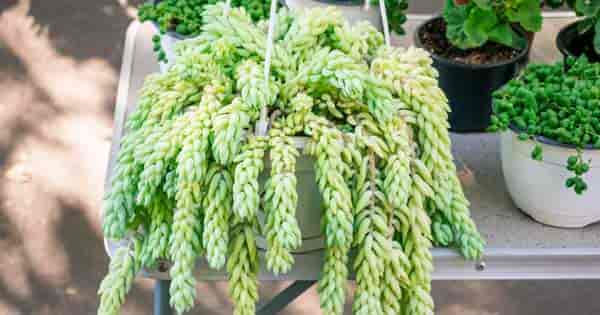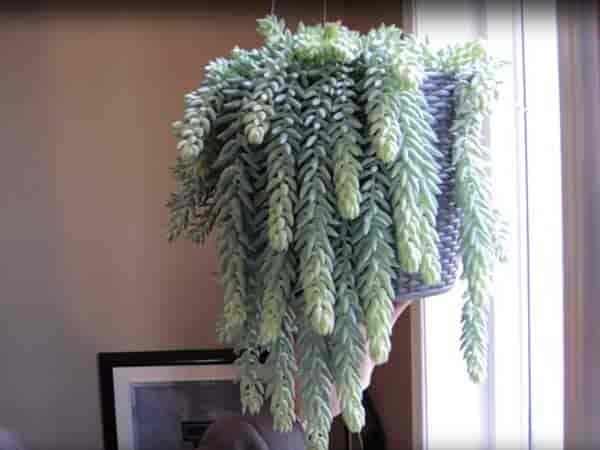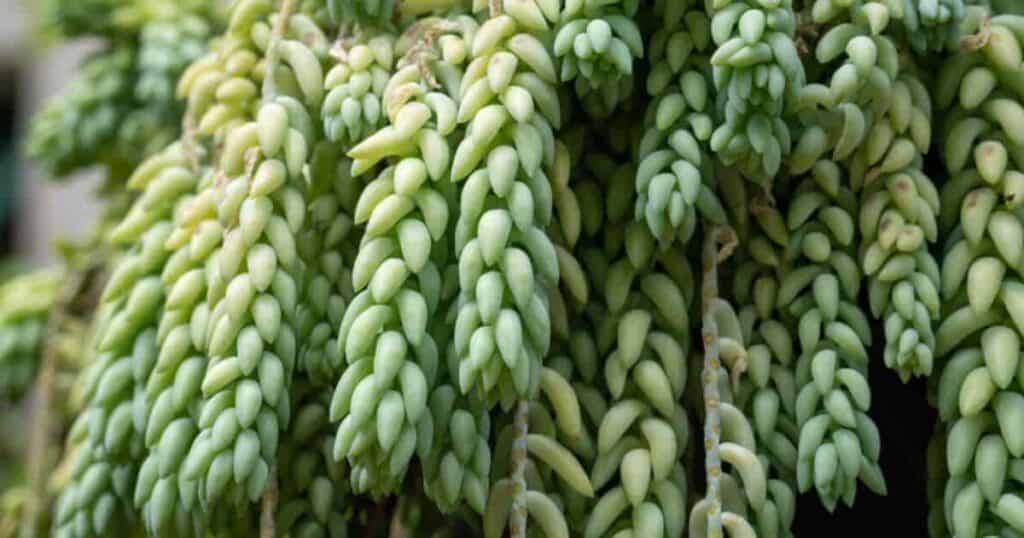The Burro’s Tail Plant (Sedum morganianum) is a small succulent known by several other names besides “Burro’s tail.”
- Donkey tail
- Lamb’s tail
- Monkey tail
- Horse’s tail

I’ve always called it Burro’s tail.
Related: Growing Succulent Plants Outdoors
The Morganianum Sedum is native to Mexico and is one of approximately 600 species in the genus, Sedum, which is a member of the Crassulaceae (stonecrop) family. [source]
These small, succulent plants, native to most parts of the Northern Hemisphere, are popular as both landscape and container plants.
Sedum Morganianum Quick Care Tips
- Botanical Name: Sedum morganianum
- Common Name(s): Donkey Tail Sedum, Burro’s Tail, Horse’s Tail, Donkey tail, Lamb’s tail. Monkey tail
- Synonyms: Sedum burrito, Sedum donkey tail
- Pronunciation: SEE-dum Mor-gan-ee-AY-num
- Family & Origin: Crassulaceae family, native to Mexico and most parts of the Northern Hemisphere
- Growability: Easy to grow
- Grow Zone: USDA zones 10-11
- Size: Can grow up to 1′ to 4′ feet long
- Flowering: Produces small, star-shaped, and unscented in shades of pink and red
- Light: Prefers bright, indirect light or full sun
- Humidity: Prefers medium-humidity room
- Temperature: Thrives in warm temperatures between 50° – 60° degrees Fahrenheit
- Soil: Commercial cactus mix
- Water: Water regularly, allowing soil to dry out between waterings
- Fertilizer: Fertilize with weak solution of cactus fertilizer two or three times through spring and summer
- Pests & Diseases: Can be susceptible to mealybugs and spider mites. Overwatering can lead to root rot.
- Propagation: Propagate through leaf
- Plant Uses: Makes a great hanging plant or can be used in succulent arrangements.
In this article, we will share growing, care and use information on the Burro’s Tail. Read on to learn more.
What Does The Burros Tail Look Like?
Unlike most other members of this group, morganianum has long, pendulous stems, which inspired its common name – Burro’s Tail. By the way, it is a succulent not as cactus as some think.
The stems are heavily leaved and do look rather like a donkey or burro’s tail (if it were green). Healthy, mature specimens can produce large numbers of donkey tails reaching a length of three or four feet!
If you don’t have room for a plant sporting up to a hundred four-foot-long tails, you can opt for the smaller version of the plant, Baby Donkey Tail (Sedum burrito).

This is a dwarf version of the original, and it only grows to be about half as big.
The leaves are between a quarter and a half inches long, and the tails reach a maximum of about a foot and a half.
On the other end of the spectrum, you could choose Giant Burro’s Tail (succulent Sedeveria), which is a cross between Burro’s Tail (Sedum morganianum) and the different varieties of Echeveria plants.
This plant has very large, pointed leaves. It grows both hanging tails and upright stalks, about 1′ to 4′ feet long.
No matter which variety you choose, this plant seldom produces flowers, and when it does, they are small, star-shaped, and unscented in shades of pink and red. [source]
The real drawing card for this plant is its plump, interesting leaves. These hang from the stem in an overlapping pattern to create the “tail” illusion.
Leaves are pale green and dusted with a waxy, pale blue powder. When you handle the plant, this powder rubs off, but fear not, it will develop again shortly.
Recommended Reading:
- How To Grow and Care For Hens and Chicks – Sempervivum [Houseleek]
- Rat Rail Cactus Growing and Care
- String Of Pearls Plant Care
What Is The Best Use Of Burro’s Tail?
All versions of the morganianum succulent are good choices for sunny settings.
These hardy plants do well as indoor house container plants in a sunny window, on a balcony setting, on a patio, or near your pool.
Smaller versions (sedum burrito) make lovely hanging baskets with their “tails” trailing over the edge.
It’s best to place the containers in an out-of-the-way location as the leaves tend to fall off easily when disturbed.

Donkey Tail Care
A plant for the neglectful plant lover is one of the best ways to describe caring for a Burro’s tail. They can be quite happy growing in sandy soil with a little sun in the morning.
However, below are some care and growing guidelines.
Donkey Tail Cactus Light Requirements
These plants love very bright light with a minimum of four hours daily.
Some who grow the Horse’s tail recommend full sun, but I’ve noticed the plants become “yellow” when grown in the blazing full sunlight in summer.
It also thrives in USDA hardiness zones 10 to 11.
What Room Temperature Does The Donkey Tail Succulent Like?
In tropical climates, Lamb’s Tail plants can stay outdoors year-round. In areas where it freezes in winter, bring this succulent plant indoors during the winter months.

Wintertime temperatures should be between 50° – 60° degrees Fahrenheit. During the spring and summer, comfortable room temperatures or warmer are fine.
Tips On Burro’s Tail Watering
Unlike many succulents, these plants need quite a bit of water to keep the many leaves plump and attractive. Water deeply and regularly throughout the growing season.
You should give the plant a very thorough watering and then wait for the soil to dry before watering again.

Be sure to check the soil often. Very large, mature plants may need to be watered more frequently. Make sure not to give too much water!
Reduce Watering In The Wintertime – Your goal should be just to prevent shriveling leaves. If you see the leaves begin to shrivel, it is a sure sign you need to water.
If this does happen, don’t get upset. They will plump back up again, and if they don’t, you can always pluck them off. More will grow soon.
It also thrives in medium-humidity rooms and cannot tolerate high humidity levels.

Burros Tail Care: Fertilizing
Fertilizer your Burros tail is not essential, but you can feed a weak solution of cactus fertilizer two or three times through spring and summer.
Don’t feed more than once a month. In winter, don’t feed at all.
What Is The Best Soil For A Sedum Or Succulent?
A commercial cactus mix is ideal. You can also make your own well-draining soil mixture by combining equal parts potting soil and perlite or pumice.

More on: How To Make The Best Soil For Cactus
Repotting The Burros Tail Plant
When repotting, repot gradually, as needed, up to about a six or eight-inch pot or hanging basket. After that, just supplement the existing potting mix with fresh soil occasionally.
It is not a good idea to completely repot or transplant mature plants as it is very difficult to avoid damaging the plant.
The donkey tail is a delicate and brittle succulent. They easily break up when handled.
TIP: Before repotting do a little preplanning and preparation. Stop watering the plant for several weeks and allow the leaves to crinkle slowly. This allows the plant to be more flexible when handling the repotting and transplanting.
Burro’s Tail Propagation
Propagating, rooting, and starting the burro’s tail and sedum plants, in general, could not be easier.
The reason the leaves fall off easily is that in nature, they simply fall to the ground, take root and grow up as brand-new plants.
If you keep your Burro’s Tail plant among a group of other potted plants, you will soon see little “tails” shooting up in the soil of the plant’s neighbors.

Simple leaf propagation involves plucking off fat, healthy leaf cuttings (or picking up one that has fallen) and dropping it onto the surface of a small pot of well-drained soil. Cactus soil is ideal.
Plain perlite, coco coir, or sand will also work.
Keep the soil slightly moist (use a spray bottle) and place the pot in a warm setting with bright, indirect lighting.
Before you know it, a little plant will begin to grow from the base of the leaf.
When the baby plant is about a half inch across, it is ready to be transplanted into its own small pot.
It’s best to begin with a one-inch pot and repot as needed. These plants do well and look pretty in classic terra cotta.
Decorated, Mexican ceramic pots also look lovely when planted with Burro’s tail.
If you want to get complicated, you can also propagate these plants from stem cuttings.
Trim off the last 2 or 3 inches of a stem and remove the leaves from the lower part of the stem.
Allow the stem to dry or harden up for a couple of days and then plant it in a half-inch pot of cactus potting soil.
Keep the soil lightly moist and set the pot in a bright, warm setting. Your plant should put out roots shortly. When it shows significant growth, repot as needed.
Burro’s Tail Pests And Problems
As with most succulent plants, mealybugs on succulents can sometimes be a problem, and the burro’s tail is no different.

Mealy Bugs
If your plant seems stunted and just isn’t thriving, check the leaf axils for mealy bugs. They can be hard to detect because they hide in the folds of the plant.
If you see them, treat the plant right away with a commercial pesticide or a Neem oil solution. Be sure to drench the soil with Neem oil as well because mealybugs also like to feed on roots and hide there in the soil.
Root Rot
Too much water or plants growing in soil that does not drain correctly can develop root rot and or rot in the stems and crown.
When this happens, it’s best to collect healthy leaves and stem tips and discard the rest of the plant.
Start over with the parts of the plant you’ve been able to salvage, and be sure to use good quality, light, airy, well-drained soil. Don’t overwater, and provide ample light!
Low Light Problems
If your plant’s stems seem stretched and the leaves are pale and falling off excessively, you are not providing enough light.

Prune back spindly parts and move your plant to a setting where it will receive at least four hours of bright sunlight daily.
Falling or Dropping Leaves
The slightest touch of the leaves on the sedum donkey tail can cause the leaves to fall off. Keep or hang the plant where people or objects cannot brush up against it.
Is the Burros Tail Toxic To Dogs and/or Cats?
According to the ASPCA, the burro’s tail, horse’s tail, donkey’s tail, and lamb’s tail are NON-TOXIC to dogs, cats, and horses.
Details on the question: Is the Donkey Tail Plant Poisonous?
Related: Check Out These 30 Cat Safe House Plants
Where To Buy Burro’s Tail?
These plants are easy to find in nurseries and home garden centers, growing in baskets.
They are also frequently available at local plant sales or gifted by a friend or acquaintance.
Or you can scavenge fallen leaves from your local garden center, as this video suggests!
All varieties of Burros Tail are an excellent choice for a novice gardener because they are very easy to care for.
Individual plants live a very long time, and you are sure to have plenty of baby plants standing by to take the parent’s place.
